Posts Tagged ‘emergency vet’
Winter Care for Pets: How to Keep Your Furry Friends Safe and Cozy
 As temperatures drop and the winter season settles in, it’s important to ensure your pets are prepared for the cold weather ahead. At Olsen Veterinary Clinic, we want to help you protect your four-legged family members throughout these chilly months. From safe outdoor practices to holiday hazards, we’ve gathered some essential tips to keep your pets healthy, warm, and happy all winter long.
As temperatures drop and the winter season settles in, it’s important to ensure your pets are prepared for the cold weather ahead. At Olsen Veterinary Clinic, we want to help you protect your four-legged family members throughout these chilly months. From safe outdoor practices to holiday hazards, we’ve gathered some essential tips to keep your pets healthy, warm, and happy all winter long.
Bundle Up for Outdoor Time
Even pets with thick fur can feel the effects of winter.
🐾 Limit time outside — Prolonged exposure to cold temperatures can lead to hypothermia or frostbite. Quick walks and supervised play are best.
🐾 Dress for the weather — Short-haired dogs may need sweaters or jackets to retain body heat.
🐾 Protect the paws — Salt, ice, and cold pavement can irritate paw pads. Booties or pet-safe balms can help shield sensitive feet.
🐾 Wipe down after walks — Rock salt and antifreeze are toxic! Clean paws and bellies to stop pets from licking dangerous chemicals.
Create a Cozy Indoor Environment
Winter is the perfect time to make things warm and comfortable for your pets.
🔥 Provide warm bedding — Keep beds off cold floors and away from drafts.
🍽️ Stay on top of nutrition — Some pets may burn more calories staying warm. Ask us if diet adjustments are needed.
💧 Hydrate — Pets can dehydrate in winter, too! Ensure access to fresh, unfrozen water.
🐶 Keep them active — Indoor play, puzzle toys, and short training sessions help prevent winter boredom.
Holiday Safety Tips
The festive season can bring some unexpected risks for pets.
🎄 Decorations with caution
Tinsel, ribbons, and ornaments can be choking hazards. Keep cords and candles out of reach.
🍫 Watch what they eat
Chocolate, holiday sweets, table scraps, and alcohol are dangerous for pets. Remind guests not to feed your furry friends.
🌱 Avoid toxic plants
Mistletoe, holly, and certain types of lilies can be harmful if chewed or ingested.
🎁 Safe gift-giving
Opt for pet-friendly chew toys and avoid items that could splinter or break apart easily.
Car Safety Still Matters
Cold weather doesn’t eliminate vehicle dangers.
🚗 Never leave pets unattended in vehicles
Cars can act like refrigerators, rapidly dropping to unsafe temperatures.
🐱 Check before you drive
Outdoor cats may seek warmth under your car. Tap the hood to be sure no one is hiding near the engine.
Schedule a Winter Wellness Check
Cold weather can aggravate arthritis, respiratory concerns, and other chronic conditions. A seasonal check-up at Olsen Veterinary Clinic can help ensure your pet is ready for winter.
We’re Here for You All Season Long
If you ever notice signs of frostbite, hypothermia, or sudden behavior changes, contact Olsen Veterinary Clinic right away. Winter can be a fun and cozy time for pets—with the right precautions in place!
📞 Call us today to schedule your winter wellness visit
🐾 Your pet’s health and comfort are our top priority.
Thanksgiving with Pets: The Do’s and Don’ts for Holiday Meals
 Thanksgiving is a time for gratitude, family, and of course, delicious food! While we love to include our furry friends in the celebration, it’s important to remember that not everything on the holiday table is safe for pets. At Olsen Veterinary Clinic, we want to help you and your pets enjoy a happy and healthy Thanksgiving together.
Thanksgiving is a time for gratitude, family, and of course, delicious food! While we love to include our furry friends in the celebration, it’s important to remember that not everything on the holiday table is safe for pets. At Olsen Veterinary Clinic, we want to help you and your pets enjoy a happy and healthy Thanksgiving together.
🐾 The Do’s: Safe Ways to Include Your Pets in the Feast
✅ Do share in moderation.
Small, plain portions of pet-safe foods can be a fun treat. Turkey meat (without skin or seasoning), plain green beans, carrots, or pumpkin puree are all healthy options — just keep portions small.
✅ Do keep their routine.
The excitement of guests and new smells can be stressful for pets. Stick to your pet’s regular feeding and walking schedule to keep them calm and comfortable throughout the day.
✅ Do create a quiet space.
If you’re hosting a large gathering, give your pet a quiet room to retreat to with their bed, water, and toys. This helps prevent anxiety and keeps them out of the kitchen chaos.
✅ Do secure the trash.
Thanksgiving leftovers can be tempting, but bones, string, and food wrappers can cause serious harm if swallowed. Make sure the trash is pet-proof and taken out promptly.
🚫 The Don’ts: Foods and Habits to Avoid
❌ Don’t feed turkey bones or skin.
Bones can splinter and cause choking or internal injuries. The skin is high in fat and may lead to pancreatitis, a painful and dangerous condition for dogs and cats.
❌ Don’t give foods with onions, garlic, or chives.
These ingredients, common in stuffing and gravy, are toxic to both dogs and cats and can cause serious digestive and blood problems.
❌ Don’t let them nibble on desserts.
Chocolate, xylitol (found in sugar-free treats), raisins, and grapes are all toxic to pets. Even a small amount can cause severe illness.
❌ Don’t forget about alcohol.
Even small sips of beer, wine, or cocktails can be dangerous for pets. Keep all drinks out of reach.
🐶 A Happy, Healthy Holiday
Thanksgiving can be a joyful experience for you and your pets when you plan ahead. Offer pet-safe treats, keep the dangerous foods off their plates, and stick to routines that make them feel secure.
If your pet gets into something they shouldn’t, contact Olsen Veterinary Clinic right away or reach out to the nearest emergency veterinary service. Quick action can make all the difference.
From all of us at Olsen Veterinary Clinic, we wish you and your furry family members a safe and wonderful Thanksgiving!
Summer Safety Tips: Keeping Your Pets Cool and Comfortable

As the temperatures rise and summer sets in, it’s important to remember that the heat can be just as uncomfortable—and even dangerous—for your pets as it is for you. At Olsen Veterinary Clinic, we care deeply about your furry family members and want to ensure they stay safe, happy, and healthy all summer long.
Here are some essential tips and advice for avoiding heat-related illnesses and keeping your pets cool during the summer months:
☀️ Understand the Risks of Heat for Pets
Unlike humans, pets don’t sweat to cool down (aside from a bit through their paws). Dogs mainly cool off by panting, and cats often rely on finding shady, cool areas. But in extreme heat, these natural cooling mechanisms may not be enough.
Heatstroke is a serious, potentially fatal condition in pets. Signs include:
- Excessive panting or drooling
- Rapid heartbeat
- Lethargy or unresponsiveness
- Vomiting or diarrhea
- Bright red or pale gums
If you suspect heatstroke, move your pet to a cool area and contact Olsen Veterinary Clinic immediately at [your clinic phone number].
🌳 Provide Shade and Fresh Water
Whether your pet is indoors or outdoors, make sure they always have access to:
- Fresh, cool water (consider adding ice cubes!)
- Shaded areas if they’re outside—trees, tarps, or doghouses with ventilation
- Cool indoor spots away from direct sunlight
Pro tip: Use a cooling mat or damp towel for your pet to lie on indoors.
🚗 Never Leave Your Pet in a Parked Car
Even with the windows cracked, the temperature inside a parked car can skyrocket in minutes. On an 85°F day, the interior can reach over 100°F in just 10 minutes. This can quickly lead to heatstroke or worse.
Leaving pets in cars is dangerous and potentially deadly. Always take them with you or leave them safely at home.
🐾 Be Mindful of Hot Pavement
If it’s too hot for your bare feet, it’s too hot for your pet’s paws. Asphalt, sand, and concrete can cause painful burns. Walk your dog early in the morning or later in the evening, and consider pet booties for extra protection.
🐕🦺 Exercise Smart
Limit intense exercise during the hottest parts of the day. Opt for short walks, indoor play, or water activities like kiddie pools or sprinklers.
Some breeds—like pugs, bulldogs, and Persian cats—are more prone to heatstroke due to their short noses and breathing difficulties. Take extra care with these pets.
🍦 Cool Treat Ideas
Give your pets a summer treat:
- Frozen dog-safe fruits like watermelon or blueberries
- Ice cubes with treats or peanut butter inside
- Pet-safe frozen yogurt or broth popsicles
Always check ingredients to ensure they’re safe for your specific pet!
🏡 Know Your Pet’s Limits
Every animal is different. Older pets, overweight pets, and those with medical conditions may struggle more with heat. Watch for signs of discomfort and adjust their routines accordingly.
😎 Stay Cool with Olsen Veterinary Clinic
If you have concerns about your pet’s health in the heat, or want personalized advice for your pet this summer, don’t hesitate to contact us. We’re here to help you enjoy the season safely with your furry companions!
April is National Heartworm Awareness Month: What Pet Owners Need to Know
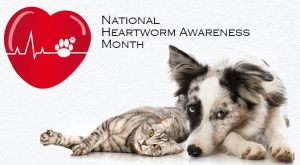 At Olsen Veterinary Clinic, we believe that knowledge is the first step in protecting your pets. That’s why we’re highlighting National Heartworm Awareness Month this April — a crucial time to educate pet owners on how to prevent and treat this potentially deadly disease in dogs and cats.
At Olsen Veterinary Clinic, we believe that knowledge is the first step in protecting your pets. That’s why we’re highlighting National Heartworm Awareness Month this April — a crucial time to educate pet owners on how to prevent and treat this potentially deadly disease in dogs and cats.
What is Heartworm Disease?
Heartworm disease is a serious and sometimes fatal condition caused by parasitic worms (Dirofilaria immitis) that live in the heart, lungs, and associated blood vessels of affected pets. It is spread through the bite of an infected mosquito and can lead to severe lung disease, heart failure, and damage to other organs.
Dogs and Heartworms
Dogs are natural hosts for heartworms, which means the parasites can live, mature, and reproduce inside them. An untreated infection can lead to permanent damage to the heart and lungs.
Symptoms in dogs may include:
-
Persistent cough
-
Fatigue after moderate activity
-
Decreased appetite
-
Weight loss
-
Swollen belly from fluid buildup
-
In severe cases, sudden collapse or death
Cats and Heartworms
Cats are atypical hosts, so heartworms don’t usually survive to the adult stage. However, even immature worms can cause significant respiratory issues and sudden death. Unlike in dogs, heartworm disease in cats is more difficult to detect and diagnose.
Symptoms in cats may include:
-
Coughing or asthma-like attacks
-
Vomiting
-
Loss of appetite
-
Weight loss
-
Difficulty walking
-
Fainting or seizures
-
Sudden collapse or death
Prevention is the Best Medicine
Heartworm prevention is simple, safe, and cost-effective, especially when compared to the stress and cost of treating an active infection.
Prevention options include:
-
Monthly oral or topical medications
-
Injectable preventatives for dogs that last up to 6–12 months
-
Consistent testing to ensure your pet remains heartworm-free
At Olsen Veterinary Clinic, we can recommend the best prevention program tailored to your pet’s lifestyle and needs. Even indoor pets are at risk, as mosquitoes can enter your home.
Diagnosing and Treating Heartworm Disease
For dogs, a simple blood test can detect heartworm infection. If a dog tests positive, treatment involves a strict and carefully monitored protocol:
-
Stabilization of the pet’s condition
-
Administration of medications to kill adult worms and larvae
-
Strict rest during treatment to reduce risk of complications
For cats, diagnosis is more complex and may involve blood tests, X-rays, or ultrasounds. Unfortunately, there is no approved treatment for heartworm in cats. Supportive care can help manage symptoms, but prevention is absolutely essential.
Protect Your Pet Today
Heartworm disease is a year-round threat, and April serves as a great reminder to stay proactive. Whether you need to start a prevention plan, schedule a heartworm test, or just want to learn more, the team at Olsen Veterinary Clinic is here to help.
Contact us today to schedule your pet’s heartworm screening or to discuss prevention options!
Your pet depends on you for protection — and we’re here to make sure you both have a happy, heartworm-free life.
Emergency Preparedness for Pet Owners: A Guide to Keeping Your Pets Safe
 At Olsen Veterinary Clinic, we understand that your pet is not just an animal—they’re a beloved family member. Just as you prepare for emergencies in your own life, it’s crucial to have an emergency plan in place for your pets. Disasters and accidents can happen at any time, so being ready can make all the difference in ensuring your furry, feathered, or scaly friends remain safe and healthy.
At Olsen Veterinary Clinic, we understand that your pet is not just an animal—they’re a beloved family member. Just as you prepare for emergencies in your own life, it’s crucial to have an emergency plan in place for your pets. Disasters and accidents can happen at any time, so being ready can make all the difference in ensuring your furry, feathered, or scaly friends remain safe and healthy.
Here’s a comprehensive guide to help you prepare for emergencies and provide the best possible care for your pets when they need it most.
1. Create an Emergency Plan for Your Pets
Having a solid emergency plan is the first step in ensuring your pet’s safety. This plan should address several key areas:
Identify a Safe Location
- Evacuation Routes: Make sure you have a plan for evacuating your home with your pet if necessary. Know at least two or three pet-friendly shelters or hotels in your area in case you need to leave. Keep these contacts and addresses readily available.
- Transport: Have a pet carrier or leash ready for transport. If your pet is not used to a carrier, spend time getting them comfortable in it ahead of time.
- Family Communication Plan: Ensure that all family members are familiar with the emergency plan. If you are separated, have a designated contact person who can help with pet care or transport.
Important Documents and Identification
- Microchip & ID Tags: Ensure your pet has an up-to-date ID tag and microchip with your current contact information. In the event you get separated, this is often the quickest way to reunite.
- Important Records: Have copies of your pet’s medical records, vaccination history, and medications. Keep these documents in a waterproof, easily accessible folder. This will be especially helpful if you need to evacuate or visit a new vet.
2. Assemble a Pet Emergency Kit
Just like humans need an emergency kit, your pet will benefit from having their own supplies ready to go. Here’s a checklist of items to include in your pet’s emergency kit:
- Food and Water: Pack at least 3-7 days’ worth of your pet’s food and fresh water. Don’t forget a manual can opener if your pet eats canned food.
- Medications and Medical Records: Keep an extra supply of any medications your pet needs, along with their prescription details. If your pet has specific health conditions, be sure to include any relevant care instructions.
- First Aid Supplies: Include bandages, antiseptic wipes, tweezers, and other first-aid items. If your pet has specific medical conditions, pack any necessary tools, such as a thermometer for monitoring fever.
- Pet Comfort Items: Include a favorite blanket, toy, or a familiar item to reduce your pet’s stress during an emergency.
- Leash, Collar, and Harness: Ensure you have a sturdy leash, collar with ID tag, and a harness if needed.
- Sanitation Items: Waste bags, paper towels, and pet litter for cats should be included in your kit.
It’s also a good idea to keep this kit in an easily accessible place—such as by the door—so that you can grab it quickly in an emergency.
3. Know Basic First Aid for Pets
Knowing how to perform basic first aid on your pet can save their life in an emergency situation. Some simple first aid techniques include:
CPR for Pets
- Check for Breathing and Pulse: If your pet is unresponsive, check if they are breathing and have a pulse. If not, begin CPR immediately.
- CPR Steps for Dogs and Cats:
- Place your pet on their side, ensuring their airway is clear.
- Use your hands to give chest compressions. For small dogs and cats, use one hand to compress the chest. For larger dogs, use both hands.
- Give 2 rescue breaths for every 30 chest compressions. For small pets, cover the nose and mouth; for larger pets, cover the nose and mouth together.
- Continue CPR until help arrives or your pet starts breathing again.
Managing Bleeding
- Apply gentle pressure to any bleeding wounds with a clean cloth or bandage. If the bleeding is severe or doesn’t stop after 5 minutes, seek immediate veterinary care.
Choking
- For small pets: Hold your pet upside down by the hind legs, and give a few gentle shakes to try to dislodge the object.
- For larger pets: Perform a modified Heimlich maneuver by applying pressure just behind the ribcage.
Signs of Poisoning
- If your pet ingests something toxic, time is critical. Signs of poisoning include drooling, vomiting, diarrhea, lethargy, or seizures. Keep the contact number for a local poison control hotline, like the ASPCA Animal Poison Control Center, on hand.
4. When to Seek Veterinary Help in an Emergency
It’s important to know when an emergency requires professional veterinary attention. Some situations that call for immediate veterinary care include:
- Difficulty Breathing: Rapid or labored breathing is a medical emergency.
- Severe Bleeding: If the bleeding is heavy or doesn’t stop after 5 minutes, seek help.
- Seizures: If your pet has a seizure lasting more than 2 minutes, or if they experience multiple seizures, seek veterinary care immediately.
- Trauma or Injury: Any significant injury (e.g., broken bones, falls, car accidents) requires veterinary attention.
- Vomiting or Diarrhea: If your pet has persistent vomiting or diarrhea for more than 24 hours, or if it’s accompanied by lethargy, it may be time to consult your vet.
- Unresponsiveness: If your pet collapses or is unresponsive, it’s crucial to seek veterinary care immediately.
5. Prepare for Natural Disasters
If you live in an area prone to natural disasters like floods, wildfires, or hurricanes, it’s vital to have an additional layer of preparation. This might include:
- Evacuation Plans Specific to Your Area: Know the best routes to safety, and ensure you have pet-friendly evacuation shelters available.
- Pet-Friendly Disaster Supplies: In addition to your standard emergency kit, you may need specialized items, like extra blankets, warm clothing, or a pet carrier that can be easily carried in case you need to evacuate.
6. Ongoing Monitoring and Adjustment of Plans
Emergencies can happen at any time, so it’s important to regularly review and update your emergency preparedness plan. Check expiration dates on food and medications, ensure your contact information on pet IDs is accurate, and practice drills with your family members to ensure everyone is familiar with the plan.
At Olsen Veterinary Clinic, we know that being prepared for an emergency gives you peace of mind and ensures your pet’s health and safety. Emergencies can happen without warning, but by having a plan in place, assembling the right supplies, and knowing how to respond in a crisis, you’ll be able to care for your pets no matter what comes your way.
We encourage you to visit us for any questions you have about emergency preparedness or to ensure your pet’s health needs are up to date. Stay safe, and don’t wait until an emergency arises—start preparing today!
Senior Pet Care: Ensuring a Happy and Healthy Aging Process
 As our beloved pets age, their needs change significantly. At Olsen Veterinary Clinic, we understand that senior pets require specialized care to ensure they continue to lead happy, healthy lives. In this article, we will discuss the unique needs of senior pets, including diet, exercise, and healthcare considerations.
As our beloved pets age, their needs change significantly. At Olsen Veterinary Clinic, we understand that senior pets require specialized care to ensure they continue to lead happy, healthy lives. In this article, we will discuss the unique needs of senior pets, including diet, exercise, and healthcare considerations.
Understanding the Aging Process
A pet is generally considered a senior when they reach around 7 years of age, though this can vary depending on the breed. Larger breeds tend to age more quickly than smaller breeds. As pets age, they may experience a variety of physical and behavioral changes, including decreased energy, changes in mobility, weight fluctuations, and increased susceptibility to health issues.
Diet: Nutritional Needs for Senior Pets
A balanced diet is crucial for maintaining the health of senior pets. Here are some dietary considerations to keep in mind:
- High-Quality Ingredients: Look for pet food that lists high-quality proteins and is rich in essential nutrients. Senior formulas often contain modified protein levels, antioxidants, and omega fatty acids to support aging joints and overall health.
- Caloric Needs: Older pets may have lower energy requirements. Adjusting portion sizes to prevent obesity is important, as excess weight can lead to joint problems and other health issues.
- Digestive Health: Aging pets may experience changes in digestion. Foods that are easier to digest, and those containing probiotics and fiber, can help maintain gastrointestinal health.
- Hydration: Ensure that your senior pet has access to fresh water at all times. Dehydration can be a serious concern, especially in pets with kidney issues.
Exercise: Keeping Active for Physical and Mental Health
Regular exercise is vital for senior pets to maintain their physical and mental health. Here are some tips to ensure your pet stays active:
- Tailored Exercise Routines: Adjust the intensity and duration of exercise based on your pet’s ability. Shorter, more frequent walks are often better than longer sessions. Swimming can be an excellent low-impact option for many dogs.
- Mental Stimulation: Engage your pet’s mind with puzzle toys, training sessions, or new experiences. This is especially important as cognitive function can decline with age.
- Watch for Signs of Discomfort: Be mindful of how your pet reacts to exercise. If they seem fatigued or show signs of pain, it may be time to modify their routine.
Health Care Considerations: Regular Check-ups and Preventative Care
Regular veterinary check-ups become even more critical as pets age. Here are key healthcare considerations:
- Routine Veterinary Visits: Schedule veterinary check-ups at least twice a year. These visits can help catch potential health issues early, including dental disease, arthritis, and organ dysfunction.
- Vaccinations and Preventative Medications: Stay up-to-date on vaccinations and parasite prevention. Senior pets may be more vulnerable to diseases, and preventative care is essential.
- Blood Work and Screenings: Regular blood tests can provide insight into your pet’s internal health. Early detection of conditions like kidney disease or diabetes can lead to more effective management.
- Dental Care: Dental health is often overlooked but is crucial for senior pets. Regular dental cleanings and at-home dental care can prevent painful dental diseases and associated health issues.
- Pain Management: Many senior pets experience chronic pain due to arthritis or other conditions. Consult with your veterinarian about pain management options, including medications, supplements, and alternative therapies like acupuncture.
Caring for a senior pet can be incredibly rewarding. By paying attention to their unique dietary, exercise, and healthcare needs, you can help ensure they remain happy and healthy throughout their golden years. At Olsen Veterinary Clinic, we’re here to support you and your senior pet with personalized care plans and compassionate guidance. If you have any questions or concerns about your pet’s health, please don’t hesitate to reach out to our team. Together, we can make the aging process a joyful experience for you and your furry companion.
Tips for Traveling with Pets: A Guide from Olsen Veterinary Clinic
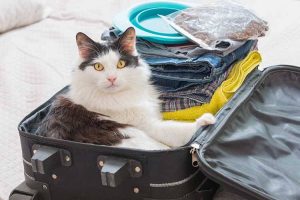 Traveling with pets can be a rewarding experience, but it requires careful planning and preparation to ensure a safe and comfortable journey for both you and your furry companion. Whether you’re taking a road trip, flying, or using public transportation, here are some essential tips to make your travel smooth and enjoyable.
Traveling with pets can be a rewarding experience, but it requires careful planning and preparation to ensure a safe and comfortable journey for both you and your furry companion. Whether you’re taking a road trip, flying, or using public transportation, here are some essential tips to make your travel smooth and enjoyable.
Preparation Before the Trip
- Visit the Veterinarian:
- Schedule a check-up to ensure your pet is healthy and up-to-date on vaccinations.
- Obtain a health certificate if required by your destination.
- Discuss any travel concerns and ask for recommendations on calming aids if your pet is prone to anxiety.
- Microchip and Identification:
- Make sure your pet is microchipped and the information is current.
- Attach an ID tag with your contact information to your pet’s collar.
- Pet-Friendly Accommodations:
- Research and book pet-friendly hotels or lodgings in advance.
- Confirm pet policies, including any restrictions or additional fees.
- Pack Essentials:
- Bring enough food and water for the duration of the trip, plus extra in case of delays.
- Include bowls, a leash, a waste disposal bag, grooming supplies, a first-aid kit, and any medications your pet needs.
- Pack a favorite toy or blanket to provide comfort and a sense of familiarity.
Safety Measures During Travel
- Secure Your Pet:
- Use a pet carrier, travel crate, or a pet seatbelt to keep your pet safe in the car.
- Ensure the carrier is well-ventilated and spacious enough for your pet to stand, turn around, and lie down comfortably.
- Never Leave Pets Unattended:
- Never leave your pet alone in a parked car, as temperatures can quickly become dangerous.
- If you need to stop, take your pet with you or ensure someone stays with them.
- Regular Breaks:
- Plan for regular breaks (every 2-3 hours) to allow your pet to stretch, relieve themselves, and hydrate.
- Use a leash and harness during stops to prevent your pet from running off in unfamiliar surroundings.
Stress-Reducing Strategies
- Comfortable Environment:
- Keep the carrier or crate cozy with your pet’s favorite blanket or bedding.
- Maintain a calm and quiet environment by minimizing loud noises and sudden movements.
- Familiarization:
- Gradually acclimate your pet to their carrier and the car before the trip.
- Take short practice trips to help your pet get used to the sensation of traveling.
- Calming Aids:
- Consider using natural calming aids like pheromone sprays or anxiety wraps.
- Consult with your veterinarian about the use of calming medications if your pet has severe travel anxiety.
- Stay Calm:
- Your pet can sense your emotions, so remain calm and relaxed to help reduce their stress.
- Speak to your pet in a soothing tone and provide reassurance throughout the journey.
Tips for Specific Modes of Travel
- Car Travel:
- Keep windows closed to prevent your pet from sticking their head out, which can be dangerous.
- Use sunshades to block direct sunlight and keep the car cool.
- Air Travel:
- Choose a pet-friendly airline and review their pet travel policies.
- Book a direct flight to minimize stress and reduce the risk of layovers or missed connections.
- Label your pet’s carrier with your contact information and a “Live Animal” sticker.
- Public Transportation:
- Check the specific regulations of the transportation service regarding pets.
- Ensure your pet is comfortable in their carrier and follow any rules regarding pet containment.
By following these tips from Olsen Veterinary Clinic, you can help ensure a safe, comfortable, and stress-free travel experience for you and your pet. Remember, preparation and patience are key to a successful journey with your furry friend. If you ever have any questions about your pet, contact us today. Happy travels!
The Importance of Regular Veterinary Check-ups
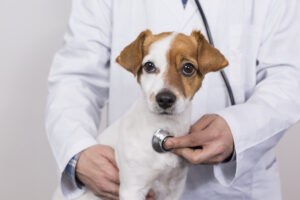 Regular veterinary check-ups are crucial for maintaining the overall health and well-being of your pets. These routine visits play a key role in preventative care and early detection of health issues. Here are some reasons why regular veterinary check-ups are important.
Regular veterinary check-ups are crucial for maintaining the overall health and well-being of your pets. These routine visits play a key role in preventative care and early detection of health issues. Here are some reasons why regular veterinary check-ups are important.
Preventative Care:
Regular check-ups allow veterinarians to administer vaccinations, parasite control, and dental care. Preventative measure can help protect your pet from various illnesses, ensuring they lead a healthier longer life.
Early Detection of Health Issues:
Pets, like humans, can develop health issues that may not be immediately apparent. Regular check-ups enable veterinarians to detect potential health problems early, often before symptoms become severe. Early detection can significantly improve the prognosis and treatment outcomes.
Disease Screening:
Veterinary check-ups may include screenings and tests for common pet diseases. These screenings can help identify conditions such as diabetes, kidney disease, and certain types of cancer in their early stages, allowing for timely intervention.
Dental Health:
Dental issues are common in pets, and they can lead to various health problems if left untreated. Regular veterinary visits often include dental examinations and cleanings, promoting good oral health and preventing dental diseases.
Nutritional Guidance:
Veterinarians can provide guidance on proper nutrition based on your pet’s age, breed, and health condition. A well-balanced diet is essential for maintaining your pet’s overall health and preventing nutrition-related issues.
Behavioral Assessment:
Veterinarians can assess your pet’s behavior during routine visits. Changes in behavior may be indicative of underlying health issues and addressing them early can prevent further complications.
Weight Management:
Maintaining a healthy weight is crucial for your pet’s well-being. Regular check-ups allow veterinarians to monitor your pet’s weight and provide guidance on nutrition and exercise to prevent obesity-related health issues.
Senior Pet Care:
As pets age, their healthcare needs may change. Regular check-ups become even more critical for senior pets to monitor and address age-related conditions, such as arthritis, dental problems, and organ dysfunction.
Client Education:
Veterinary visits are an opportunity for pet owners to learn about their pet’s specific needs, behaviors, and potential health risks. Education from veterinarians empowers pet owners to provide the best care possible.
In summary, regular veterinary check-ups are essential for preventative care, early detection of health issues, and ensuring that your pets lead healthy and happy lives. Establishing a consistent schedule of veterinary visits can contribute significantly to the overall well-being of your beloved companions. Contact our office today to schedule yours or if you have any questions.
Dr. Olsen’s Breed Spotlight: The Irish Wolfhound
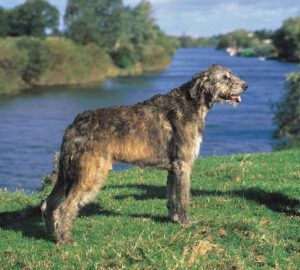 For this next breed spotlight, I will be introducing you to the Irish wolfhound, likely for the first time. This dog is calm, dignified, and the tallest breed of dog (sorry Great Danes). Early ancestors of Irish wolfhounds were fearless, big-game hunters who could dispatch a wolf in single combat. Today, they are the most serene and agreeable of companions.
For this next breed spotlight, I will be introducing you to the Irish wolfhound, likely for the first time. This dog is calm, dignified, and the tallest breed of dog (sorry Great Danes). Early ancestors of Irish wolfhounds were fearless, big-game hunters who could dispatch a wolf in single combat. Today, they are the most serene and agreeable of companions.
The amiable Irish Wolfhound is an immense and muscular hound. They are built along classic Greyhound lines, capable of great speeds at a gallop. A male might stand nearly three feet at the shoulder and can weigh up to 180 pounds. Females will run smaller but are still a very large dog. They have a rough and hard coat that can come in many colors. They can be white, gray, brindle, red, black, and fawn. Irish wolfhounds are way too serene to be fierce guard dogs, but the mere sight of the size of these dogs are enough to deter intruders. Irish wolfhounds are characteristically patient with kids, but their size does require supervision when they are around small children.
The history of this wolfhound goes back to the breeding of indigenous large dogs of Britain to the Middle Eastern coursing hounds that were bartered around the known world in the earliest days of international trade. By the time the Roman Empire had gained a toehold in the British Isles, the giant hounds of Ireland were already long established. In the year 391, the Roman consul received a gift of seven of these hounds that “all Rome viewed with wonder”. These majestic hunters, whose motto was “gentle when stroked, fierce when provoked”, were used on such quarry as the now-extinct Irish elk, a massive, ferocious beast said to stand six feet at the shoulder. In 15th-century Ireland, wolves were overrunning the countryside. The Irish hounds, already renowned big-game hunters, began to specialize on wolves. By the late 1700s, when wolves and other big-game animals of Ireland were hunted to extinctions, Irish wolfhounds lost their job and nearly went extinct themselves. This is a case of a breed doing its job too well for its own good. In 1862, British army captain George Augustus Graham began scouring the country for remaining specimens of Ireland’s national hound. Graham made it his life’s work to protect, standardize, and promote the breed. Today, his name is still spoken with reverence wherever Irish wolfhound fanciers gather.
The coats of Irish wolfhounds have two layers; the outer being harsh and wiry with the under being very soft. They shed throughout the year, but not in an excessive amount. Unlike many other double-coated breeds, Irish wolfhounds don’t “blow out” their coats during an annual or semi-annual shedding season. Irish wolfhounds retain a strong instinct to hunt and chase prey, so they should only be allowed off the leash in areas that are securely fenced. As adults, Irish wolfhounds can become couch potatoes if allowed to, but regular exercise like long walks and play sessions help keep them physically and mentally healthy. A home with a large, fenced area is necessary to provide the environment needed for this breed to thrive. The breed can also exercise mind and body by participating in canine sports like tracking, agility, and lure coursing.
These gentle giants are sure are a breed with a rich history. Their ancestors’ traits reveal themselves with their passion for hunting and need for mental and physical exercise. Generally, these dogs make excellent companions for anyone with enough land to satisfy their need to run. With any questions, please feel free to contact Dr. Olsen at 618-656-5868.
The How And Why Of Trimming Your Dog’s Toenails
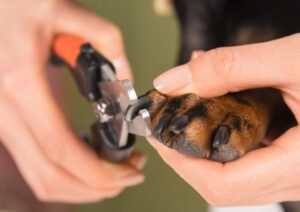 One of the most difficult things to do with your dog is to trim their nails; especially if they don’t like having their nails cut. Trimming your dog’s nails is an important grooming task that helps them stay happy and healthy. When their nails grow too long, health problems could occur. Dogs that run around on hard surfaces like concrete or blacktop, their nails are often worn down naturally. For dogs that spend most of their time indoors or running around on soft surfaces, their nails don’t get worn down regularly.
One of the most difficult things to do with your dog is to trim their nails; especially if they don’t like having their nails cut. Trimming your dog’s nails is an important grooming task that helps them stay happy and healthy. When their nails grow too long, health problems could occur. Dogs that run around on hard surfaces like concrete or blacktop, their nails are often worn down naturally. For dogs that spend most of their time indoors or running around on soft surfaces, their nails don’t get worn down regularly.
Nails that are too long are at risk of being torn off. This can result in an injury that could require veterinary care if it is serious enough. Longer nails also make it harder for dogs to walk around comfortably. If a dog’s nails hit the floor constantly as they walk, more pressure is put onto the nail bed that can cause discomfort that forces your dog to distribute their weight differently while they walk. In the end, this all can cause the way their toe and paw joints are aligned to be affected in a negative way.
If your dog is not used to having their nails trimmed, one should start getting them used to the clippers and having their paws handled. You can do this by forming a positive association with it by rewarding them with treats and praise until they allow you to clip their nails without getting too nervous.
There are several types of dog nail trimmers including scissors, guillotine-type, and grinder tools designed for dogs. You can use whatever type you are most comfortable with, or whatever works best for your dog. It is a good idea to have some sort of styptic power or other clotting power on hand to stop bleeding in case you cut a nail too short.
To trim your dog’s nails, pick up one paw, and firmly but gently place your thumb on the pad of a toe and your forefinger on the top of the toe on the skin above the nail. Make sure none of your dog’s fur is in the way. Next, push your thumb slightly up and backward on the pad, while pushing your forefinger forward. This extends the nail. Clip only the tip of the nail, straight across. Include the declaws which are located on the inner side of the paw. Lastly, avoid clipping past the curve of the nail. This helps you avoid hitting the quick, the pink area of the nail that contains the blood vessels. If you were to hit the quick, it is extremely painful and will bleed. On dogs with dark nails, there will be a chalky white ring marking the quick.
Trimming your dog’s nails can be a difficult task that you and your dog do not like. With praise and positive association, trimming time can grow to be a painless task for you and your dog. If you have any questions, feel free to contact Dr. Olsen at Olsen Veterinary Clinic at 618-656-5868.
